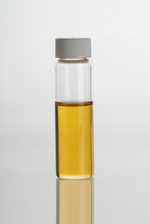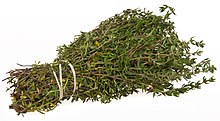Thyme oil
Thyme oil (Oleum thymi, Thymi aetheroleum) is an essential oil that is obtained from plant parts of the thyme by steam distillation . Fresh, flowering, above-ground parts of plants from various types of thyme are used for production. Thyme oil is a mixture of different substances, the composition of which varies considerably depending on the chemotype and type of thyme. The content of thyme oil is crucial for the use of thyme as a medicinal plant and as a culinary herb, as it is crucial for the taste and smell of the plant. The two officinal (medicinal) species, real thyme ( Thymus vulgaris ) and yoke thyme ( Thymus zygis ) , are of particular importance for humans .
Other thyme oils are obtained from sand thyme ( Thymus serpyllum ) (Oleum serpylli) and broad-leaved thyme ( Thymus pulegioides ) (Thymus pulegioides aetheroleum), the quendel oil , which is different in composition. The thymus capitatus is white thyme oil (Origanum Spanish) won. Oil is also obtained from Thymus algeriensis and Thymus saturejoides , or from Thymus mastichina (Spanish marjoram oil).
There is also Indian thyme oil which comes from other plant species.
Extraction
Thyme oil is obtained by eight-hour steam distillation from the dried above-ground parts of the plants that were harvested during flowering. Countries of origin are mainly Turkey (up to 70% of the world harvest in 2013), France, Spain and North Africa.
composition
| safety instructions | |||||||||||
|---|---|---|---|---|---|---|---|---|---|---|---|
| Surname |
Thyme oil, red |
||||||||||
| CAS number |
84929-51-1 |
||||||||||
|
|||||||||||
Standardized thyme oil, Aetheroleum Thymi , contains thymol as its main active ingredient .
There are seven defined chemotypes of real thyme, they are named after their main constituent. The distribution and frequency of the chemotypes within a herd depends in particular on genetic and climatic conditions. The composition of the essential oils of the chemotypes is different in each case.
- The geraniol chemotype contains up to 90% geraniol and geraniol acetate , the ratio of the two substances to one another is influenced by the season, the ester content is particularly high during midsummer.
- The linalool chemotype consists of 95% linalool, with a small amount of linalyl acetate , which is rarely up to 30%. The ratio of alcohol to ester is subject to only slight seasonal fluctuations.
- The chemotype α-terpineol contains up to 96% α-terpineol. Here the ratio of ester to alcohol is always 2: 1.
- The chemotype trans-thuyanol-4-terpineol-4 consists of up to 56% thujanol . Terpineol is contained up to 43%, another component is cis- myrcenol with a content of 10 to 20%.
- The carvacrol chemotype consists of up to 85% carvacrol, only around 0.5% is thymol.
- The thymol chemotype contains up to 65% thymol and a proportion of 5 to 10% carvacrol in summer.
- A 1,8-cineole chemotype has been described from Spain; it is absent in France.
Other important components are p-cymene , over twenty different flavones , tannins , triterpenes , phenol carboxylic acids and biphenyls .
Properties and areas of application
Depending on the origin of the thyme from which it is extracted, thyme oil is a colorless to yellowish, occasionally reddish, oily liquid. The relative density fluctuates between 0.895 and 0.937. It is practically insoluble in water and can be mixed with many organic solvents such as ethanol , ether or chloroform in any proportions. The smell is strongly spicy-phenolic, the taste is sharp.
Thyme oil has been shown to have antibacterial and antiviral effects in laboratory tests , but clinical studies on its effectiveness are lacking. The medicinal use of thyme oil has been recognized as a valuable ingredient by Commission E against catarrh of the upper respiratory tract, bronchitis and whooping cough. All other applications, for example against sore throats, intestinal and urinary tract infections, rheumatism , disinfection of wounds, for the prevention of infectious diseases as well as against undesired microorganisms such as bacteria and fungi , were rejected by it and are considered unproven.
In aromatherapy it is used against similar symptoms, also to prevent infectious diseases and undesirable microorganisms such as bacteria and fungi. As with all aromatherapy methods, however, there has been no proof of effectiveness so far.
It is also used in perfumery and for flavoring food, as well as in oral care and pharmaceutical preparations and as a massage oil.
Individual evidence
- ↑ a b c K. U. Heyland, H. Hanus, ER Keller: Oil fruits, fiber plants, medicinal plants and special crops. In: Handbuch des Pflanzenbaues. Volume 4, ISBN 3-8001-3203-6 , p. 512 f.
- ↑ Margit Steinmetz-Tomala, Christine Leitner: Enjoying like a fairy tale. Freya, 2014, ISBN 978-3-99025-154-6 .
- ↑ Ernst Steinegger, Rudolf Hansel: Pharmakognosie. 5th edition, Springer, 1992, ISBN 978-3-662-09268-2 , pp. 333 f.
- ^ Theodor Husemann : Handbook of the entire drug theory. 2nd edition, 2nd volume, Springer, 1883, ISBN 978-3-642-50380-1 (reprint), p. 541, archive.org .
- ↑ J. Wiesner : The raw materials of the plant kingdom. 5th edition, delivery 7: Ätherische Öle , J. Cramer, Weinheim 1968, p. 141.
- ^ Georg Frerichs, Georg Arends, Heinrich Zörnig: Hager's handbook of pharmaceutical practice. Volume 2, Springer, 1927, 1938, ISBN 978-3-642-88874-8 (reprint), p. 864.
- ↑ Monika Werner, Ruth von Braunschweig: Aromatherapy Practice. 3rd edition, Haug, 2012, ISBN 978-3-8304-7498-2 , p. 300.
- ^ Jürgen Falbe, Manfred Regitz: RÖMPP Lexikon Chemie. Volume 6: T – Z , 10th edition, Thieme 1999, ISBN 3-13-735110-3 , p. 4543.
- ↑ a b c d R. Hansel, K. Keller, H. Rimpler, G. Schneider (eds.): Hager's handbook of pharmaceutical practice. Volume 6, Drugs: P-Z , 5th Edition, Springer, 1994, ISBN 3-540-52639-0 , pp. 966-989, 976-979 (thyme oil).
- ↑ a b Data sheet thyme oil, red from Sanabio , accessed on June 13, 2016.
- ^ R. Granger, J. Passet: Thymus vulgaris spontane de France: races chimiques et chemotaxonomie. In: Phytochemistry. 12 (7), 1973, pp. 1683-1691, doi : 10.1016 / 0031-9422 (73) 80388-7 .
- ↑ Hans-Dieter Jeschkeit: Brockhaus ABC Chemie. Volume 2, 5th edition, FA Brockhaus Verlag, Leipzig 1987, ISBN 3-325-00099-1 .
- ↑ Phytodoc: Information on the medicinal plant Echter Thyme, introduction, (online) , accessed on March 5, 2009.
- ↑ Phytodoc: Information on the medicinal plant real thyme, areas of application and mode of action, (online) , accessed on March 5, 2009.
- ↑ Jean VALNET: aromatherapy. Heye, Paris 1986, ISBN 3-453-41728-3 , p. 204.
- ^ B. Cooke, E. Ernst: Aromatherapy: a systematic review. In: The British Journal of General Practice. 50 (455), 2000, pp. 493-496, PMC 1313734 (free full text).







